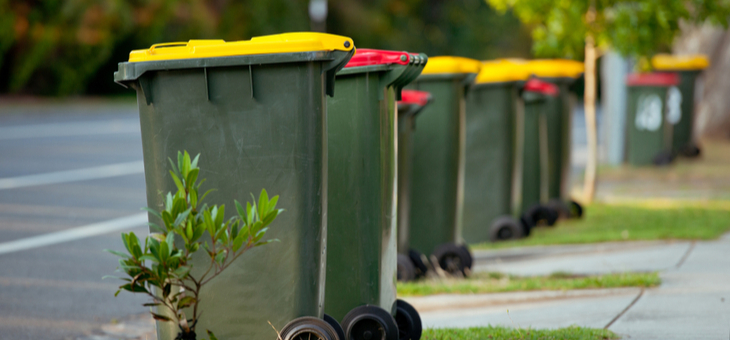How many wheelie bins are collected by your council? And how diligent are you at sorting the wheat from the chaff?
I now have four bins: one for glass, one for organics, one for paper, cardboard and recyclable plastic, and one for everything else to go into landfill. I take my bin duties seriously – I remove the plastic lids and metal screw tops from glass bottles (no kitchenware, broken glass or screens); wash containers; pick out stray wrappers, masks and what-not from my garden waste.
The council lets us know if we’re a good recycling street via stickers on the bins and scorecards in the post. And I avoid unnecessary packaging when I can (which isn’t very often when I look at my weekly shop). I’m doing my bit, making me as deluded as the next citizen of the planet Earth.
The truth is it’s all window dressing. Barely anything is repurposed. According to National Geographic, only 9 per cent of all the plastic ever produced has been recycled, 12 per cent has been incinerated, while the rest finds its way into landfill or the natural environment, which eventually breaks down to microscopic particles that end up in everything, including us.
A study carried out by the University of Newcastle in NSW suggests that people are consuming about 100,000 tiny pieces of plastic – or 250g – every year, with the single largest source of plastic ingestion being water, both bottled and tap.
Planet Plastic has arrived and it only took 70-odd years.
Read more: Microplastics in seafood
What can I do? I want to shrug nonchalantly, like a bored Parisienne sophisticate, blowing smoke from her Gauloises.
What we can do, a honey blonde goddess from Sweden would sweetly say, is: “Burn it, baby.” The Swedes burn at least 86 per cent of their plastic, and call it “recycling”, making them, in their alternate reality, the first net-zero waste country. They even import waste to feed the flames.
Under that definition, Australia, too, could be zero-waste. Though in Melbourne, we sometimes skip the incinerator – an underground fire at a tip in the city’s west has been smouldering away for 18 months, with no-one seemingly too bothered to put it out.
And really, why would you? There’s nowhere for all our rubbish to go since the 1 July export ban on mixed plastic (tyres, dirty fuel and unprocessed glass will follow in December, with a ban on cardboard and paper exports set for July 2024), though China and India pulled the pin on receiving our waste a few years ago.
The federal government has pretty much left it up to the private sector to sort out the gigantic mess we’ve got ourselves into, which has led to mountains of paper and glass waiting for a profitable business model to bite into, while the plastic … well, it’s everywhere if it’s not carefully buried or burnt.
Read more: Things we should be recycling
There is still much debate over whether it’s best to put plastic into landfill as a way of carbon capturing, or burn it to generate electricity (only in purpose-built incinerators). Australia has 17 working or proposed waste incinerators across the country and it is yet to be seen if they become the easy solution to our rubbish system.
Back to Sweden. Stockholm University has united with Germany’s Helmholtz Centre for Environmental Research and the Norwegian Geotechnical Institute to warn us that the world is reaching an irreversible tipping point of plastic, with the ramifications impossible to predict as nanoparticles work their way into all life.
Some 50 billion tonnes will be in circulation by 2025 if our ways of business remain.
One of the study authors, Mine Tekman, says we must tackle the problem at its root.
“As consumers, we believe that when we properly separate our plastic trash, all of it will magically be recycled,” Ms Tekman says. “Technologically, recycling of plastic has many limitations, and countries that have good infrastructures have been exporting their plastic waste to countries with worse facilities.
“Reducing emissions requires drastic actions, like capping the production of virgin plastic to increase the value of recycled plastic, and banning exports of plastic waste unless it is to a country with better recycling.”
I’m thinking that does not include incinerator-happy Sweden (or Germany, which also imports plastic to burn).
Read more: How to reduce your plastic waste
So, what can I do? Continue to do my little bit. Reject single-use plastic (including masks), properly separate my plastic (1, 2 and 5 marked plastic is high value and should go into the recycle bin. Soft plastics can go to the supermarket collection), and I look forward to Victoria finally joining a container deposit scheme next year.
I still feel like I’m kicking the can down the road, but one day soon I hope Australia has a recycling system that puts Sweden’s to shame.
Are you a diligent recycler? Do you refuse to buy fruit and vegies pre-wrapped in plastic? What other measures do you take to minimise your rubbish? Why not share your strategies with other members in the comments section below?
If you enjoy our content, don’t keep it to yourself. Share our free eNews with your friends and encourage them to sign up.

